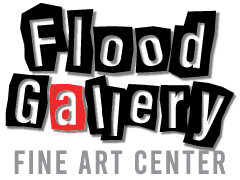“Matewan as Metaphor” Exhibit by Jean Hess

Three rooms are filled with an eclectic mix of collage paintings ranging in scale from 6×6” to 50×70”; 3-D assemblages and faux artifacts; hand-stitched textiles; documentation in the form of historic notes, catalog entries for a collection of ephemera, photographs.
Call 828-273-3332 for weekend hours or to make an appointment. Exhibits through January 17, 2023.
Flood Gallery Fine Art Center is a non-profit 501(c)3 organization, and educates, encourages, challenges and inspires the community through music, film, literary, and contemporary art.
“Matewan as Metaphor” is an experiment in artistic license. Mixed-media artist Jean Hess creates a personal story by combining real and imagined resources with the intention of healing her own memory and transcending limits on what is possible and allowed in creative and scholarly endeavors as well as in visual art. The 1920 mining labor dispute in Matewan, West Virginia, which involved her own family, stands for a full life and its adversities.
Matewan was, in 1920, the scene of an armed skirmish between coal miners, mining companies, local union officials and hired strike-breakers. Baldwin-Felts Detective Agency thugs hired by the coal operators traveled by train to cast striking miners and their families out of their homes. The local mayor and several Baldwin-Felts agents were killed. The chief of police, the Matewan mayor, and several other locals gathered at the train station to confront the hired guns about the unlawful evictions. The Baldwin-Felts agents refused to recognize the local authority, and a shootout ensued. The mayor, some miners, and several detectives were killed. This was one of many violent conflicts that took place in Southern WV between pro-union miners and men hired by coal companies to use force and intimidation to prevent miners from unionizing.
Jean Hess takes serious training in cultural anthropology and visual art to playful levels. Her mixed-media paintings and constructions come from personal memory and nostalgia, ancestral ties and historical fact. Mining illustrations and maps signify coal mining in early twentieth century Appalachia, as well as issues concerning extractive industries, population displacement, exploitative labor practices, suffering and loss. Using collage, paint, layered resins and found ephemera Hess experiments with myriad ways one can obfuscate, surprise and entice. Found imagery is from geography and history textbooks from the early 1900’s and before. Dimensional objects are from her family or found in junk shops over time. Much of her material may be deconstructed, obscured, scrambled or carefully embellished.
Jean explains her process:
“Matewan as Metaphor” is an experiment in artistic license. By combining real and imagined resources, I hope to transcend limits on what is possible and allowed in addressing history and visual art. The deadly gunfight during a 1920 mining labor dispute in Matewan, West Virginia, which involved my biological family, is my own healing metaphor for a full life and its adversities. A sort of alchemy is involved; I am trying to turn unfortunate facts into uplifting symbols. I hope this exhibit is a healing garden. I draw upon personal memory and nostalgia, ancestral ties and historical fact. Mining illustrations and maps signify coal mining in early twentieth century Appalachia, as well as issues concerning extractive industries, population displacement, exploitative labor practices, suffering and loss.
I often begin a painting by hand-drawing intricate maps and charts that help me think about the salient issues. However I typically cover everything over with multiple layers of paper, paint, other drawings and resins. Only traces of the original markings show through the layers. I might sprinkle dry metallic pigment on the surface of work – it is a sort of ritual blessing and also a way to mimic a firmament of stars.
The mixed-media paintings are accompanied by collages and assemblages, hand-stitched tapestries, collections of memorabilia either historic or contrived. All are meant to create a 1920’s mining community ambience. Everything is presented in such a way that the viewer is expected to feel as though they are in a curious-yet-touching museum.
More about the artist:
Jean Hess’ multi-variant creative output segues with an equally unpredictable life. She has lived in Washington, DC, Baltimore, Albuquerque, Santa Fe and Abiquiu, New Mexico as well as Atlanta, Dallas and now Knoxville, Tennessee. Her work-for-pay background includes stints as a computer programmer, Montessori teacher, museum registrar, writer and research consultant for government and private industry. With degrees [BA, MA] in cultural anthropology she tends to draw inspiration from wide-ranging interests, and not always according to established rules.
Hess is well-known for experimental mixed-media collage paintings and assemblages that combine the skillful use of layered paint and resins, light refraction and found materials such as antique ephemera and pressed plants. Because her palette, surface and touch are consistent, one can always tell a work of art is hers. And yet Hess likes surprises, plays with materials that are sometimes unfamiliar, operates in a controlled-experiment spirit and likes accidental detours that energize her work. While she took some undergraduate art courses she is largely self-taught.
Public collections include: Huntsville Museum of Art; Evansville Museum of Art, History and Science; Knoxville Museum of Art; University of Virginia; Farm Credit Administration; Knoxville Convention Center; City of Chattanooga; St. Mary’s Hospital Heart Institute [IN]; Canon USA.
Jean Hess is proud that much of her work is in private collections, cared for by sympathetic individuals.
 Menu
Menu